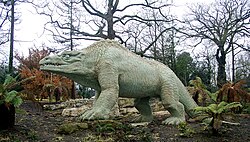Megalosaurus
Megalosaurus was a large meat-eating theropod dinosaur of the Middle Jurassic of Europe. It was found in 1824, and was the earliest dinosaur named. In 1827, Gideon Mantell included Megalosaurus in his geological survey of southeastern England. He gave the species its name, Megalosaurus bucklandii.[1]
| Megalosaurus | |
|---|---|

| |
| Fossil specimens referred to M. bucklandii, Oxford University Museum of Natural History. The display shows most of the original syntype series, including the lectotype dentary, identified by Buckland in 1824 | |
| Scientific classification | |
| Unrecognized taxon (fix): | Megalosauria |
| Family: | Megalosauridae |
| Genus: | Megalosaurus Buckland, 1824 |
| Species: | M. bucklandii
|
| Binomial name | |
| Megalosaurus bucklandii Mantell, 1827
| |
| Synonyms | |
|
Genus Synonymy
Species Synonymy
| |
Because a complete skeleton of it has never been found, much is still unclear about its build. The first naturalists who investigated Megalosaurus thought it was a gigantic lizard of twenty metres length. In 1842 Richard Owen concluded that it was no longer than nine metres, standing on upright legs as a quadruped.
Later it was realised that all theropods were bipedal. Today is known that the early proto-dinosaurs in the late Middle Triassic were also bipedal. Certainly Eoraptor, from 231.4 million years ago, was bipedal.[2] That means the dinosaurs were bipedal from the start (primatively bipedal). Only the heavier sauropods and armoured dinosaurs became quadrupedal, standing on all four legs.[3]
Megalosaurus Media
Lithography from William Buckland's "Notice on the Megalosaurus or great Fossil Lizard of Stonesfield", 1824. Caption reads "anterior extremity of the right lower jaw of the Megalosaurus from Stonesfield near Oxford".
1854 reconstruction in Crystal Palace Park guided by Richard Owen presents Megalosaurus as a quadruped; modern reconstructions make it bipedal, like most theropods
Édouard Riou's 1863 depiction of Iguanodon battling Megalosaurus
References
- ↑ Mantell G. 1827. Illustrations of the geology of Sussex: a general view of the geological relations of the southeastern part of England, with figures and descriptions of the fossils of Tilgate Forest.
- ↑ Sereno P.C. et al 1993 Primitive dinosaur skeleton from Argentina and the early evolution of Dinosauria (1993). "Primitive dinosaur skeleton from Argentina and the early evolution of Dinosauria". Nature. 361 (6407): 64–66. Bibcode:1993Natur.361...64S. doi:10.1038/361064a0. S2CID 4270484.
- ↑ Sereno PC (1999). "The evolution of dinosaurs". Science. 284 (5423): 2137–2147. doi:10.1126/science.284.5423.2137. PMID 10381873.
+{{{1}}}−{{{2}}}







